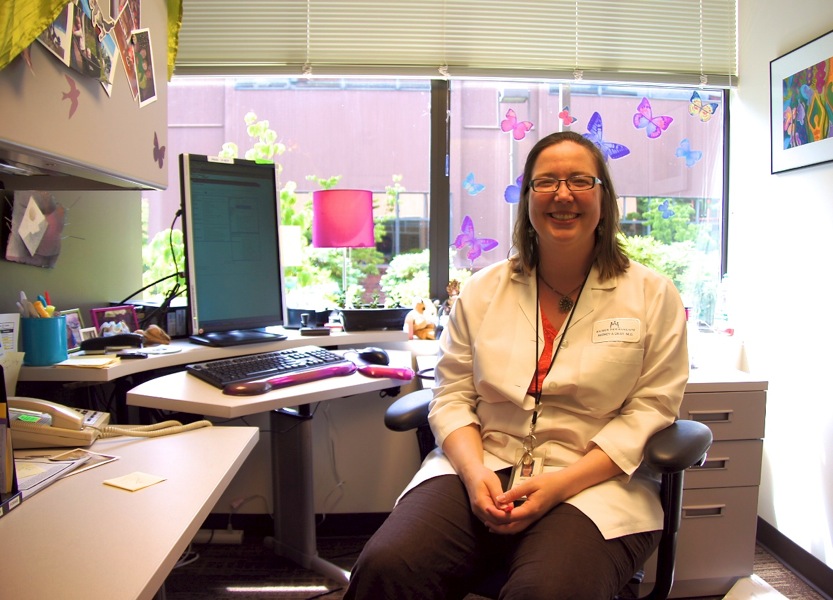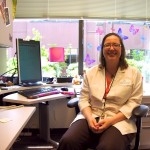The title of this post is a quote from Kaiser Permanente’s Kati Traunweiser, who met me at Kaiser Permanente Northwest (@KPNorthwest) ‘s Rockwood Medical Office, where the medical home model of care is being implemented.
She’s referring to the expression used here, “Physician led, professional managed,” which is the way this new model of care is being pioneered, with physicians leading teams that build strong, trusting relationships with patients and families to keep them healthy.
I started off in the waiting room, where Medical Office Manager Mandi Marchek found me (always start shadowing in the waiting room), and gave me a tour of the work she’s doing, followed by shadowing of Audrey Crist, MD, a family physician at Kaiser Permanente Rockwood.
I thought I would just show highlights in this blog post:
Patient Advisory Council – They have one
Mandi told me they have had one for about a year. They are working to make sure it reflects the diversity of the members being cared for. They involve the Council in improvement ideas and get their feedback.
Creating space in people’s minds for the physician telephone visit
I have known about physician telephone visits for a long time. I have never seen them explained to patients though, until now.
Mandi told me that before this work, patients would say, “I use the telephone to make appointments.” What they are doing now is helping people use the telephone to have the appointment. This is in addition to secure e-mail and in person visits, to deliver care when it is needed, preventing delays in care.
I encountered the team on this day as they were doing a “push” for virtual access to physicians and care teams through the telephone and through the kp.org personal health record. There was someone available in the reception area to sign people up and show them how to send messages to their doctor and receive lab test results.
People ask how 3.5 million people and 56% of the eligible population of members are using a personal health record. This is how.
Total health environment is a healthier care experience, especially in the pharmacy
While in the waiting room, the signs of the Total Health Environment were unmistakeable – the healing color schemes, consistent signage, and locally sourced art tipped me off :).
What Mandi showed me that was most impressive, though, was the transformation of the pharmacy area. What was formerly a space for a standing queue was now a comfortable seating area.
Mandi asked me to visualize what it might be like for a gout patient with an excruciatingly painful toe to stand while waiting for medication, even for a few moments.
Compare this to what a non-Kaiser Permanente commercial pharmacy looks like to provide a stark contrast in the medication dispensing experience (Photo: artificial food on the left, intimacy supplies on the right)
Total Health Environment is as much about health as it is experience…
Trust, Relationships, Being family physicians
The mix of patients in Audrey’s clinical day did not support another physician shadowing her (patients first), so we talked about what this transformation has been like. I also spoke with her colleague Michelle Ritter, MD, another family physician in the practice, and co-lead of the family medicine group here.
What I saw and what they told me gets back to what Kati mentioned. Her actual words to me were “You have to lead.” Impressive that this is the headline, as we were sitting in one of the most technologically advanced, post-EHR health care organizations around.
Audrey and her colleagues are learning to lead teams, enabled by next generation technology, which I have mentioned previously here tells them which patients have care gaps, what they are, and how they are doing as physicians in near real time, right down to the person.
I learned on my visit one of the reasons patients are disengaged and don’t get their preventive care is because patients they have had bad health care experiences (anywhere) in their past. The team is reaching out to these patients to change perceptions and build trust so that care gaps can be closed, risk reduced, lives saved. It’s delicate work, and it has to be done if the goal is to get from 90th percentile to 100%.
This work is similar @GroupHealth Cooperative, Seattle" target="_blank">(See: Tell me your story” : A day in the medical homes of @GroupHealth Cooperative, Seattle) to that being done at Group Health Cooperative (and who are collaborating with Kaiser Permanente Northwest), where physicians have deep personal relationships with patients, are able to spend more time with them, are able to practice at the full scope of their specialty, to perform at their best, so patients can perform at their best. This has always been the hope and dream of family medicine since it was started. I am really excited to see another place where the dream is being realized, enabled by, not because of the technology.
With great thanks to Kati, Audrey, Michelle, and the members, staff, practitioners of Kaiser Permanente Northwest for letting me watch them innovate!










3 Comments
RT @tedeytan “Physicians Have to Lead” – Innovations in the medical homes of @KPNorthwest http://hisoc.us/rbAl4p
RT @tedeytan: Post: "Physicians Have to Lead" – Shadowing Innovations in the medical homes of @KPNorthwest http://teyt.in/p1T5e3
There’s much room for growth, particularly in an emerging industry such as medical homes. I hope there’s a great community near the <a href=”http://www.beechwoodhomes.com/”>Nassau County new homes</a> we’re looking at. Keep up the good work!